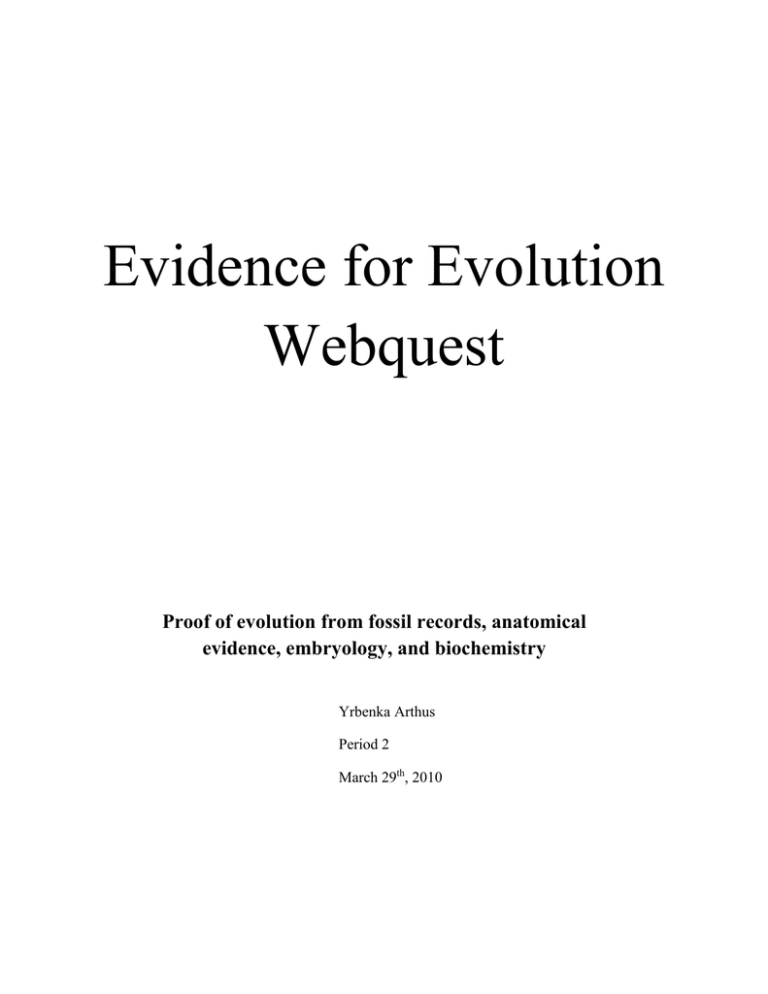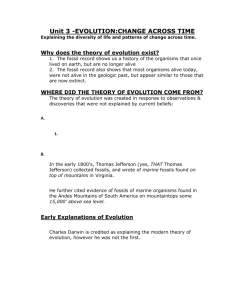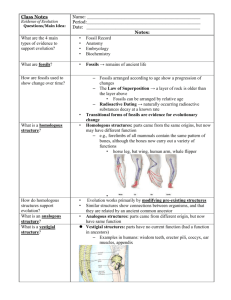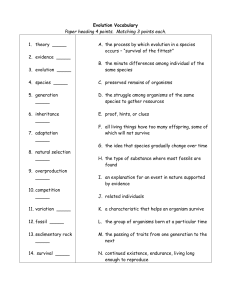Proof of evolution from fossil records, anatomical
advertisement

Evidence for Evolution Webquest Proof of evolution from fossil records, anatomical evidence, embryology, and biochemistry Yrbenka Arthus Period 2 March 29th, 2010 Fossil Evidence “The proof is in the pudding.” Well in this case, the proof is in the fossils. Fossils are remains of organisms (animals and plants) that lived long ago. There are five main types of fossils: trace fossils, casts, molds, petrified fossils, and amberpreserved fossils. Each type of fossil has its own way of telling paleontologists a story of an organism of very long ago. A paleontologist is a scientist that studies ancient life, especially fossils. They use these remains in order to discover the kinds of organisms that lived long ago, and are sometimes able to depict that organism’s behavior. Fossils are most normally found under layers of rocks. Lower layers, those further down, are the oldest—the newer layers are found on top. Over time, nature erodes soil and layers build on top of each other, burying fossils deep underground. Though hard to come by, fossils are very good clues to finding out life’s history. “Fossils can tell us about growth patterns in ancient animals.” Through fossils, paleontologists are able to determine and understand life forms of long ago. Through stories like Jurassic Park and children’s’ cartoons like Land Before Time, kids are able to learn about dinosaur—unimaginable creatures of millions of years ago. Using the fossil record, scientists learn that “there has been a tremendous variety of living things.” The evidence shows that life forms of long ago differentiate extremely from the species of today. Besides the prehistoric aspect of them, fossils are nothing new. Until this day, fossils have been turning up everywhere. Entire organism-outlines of fossils have been found; others remain jigsaw puzzles. Oftentimes, there appears to be “gaps in the fossil record are due to incomplete data collection.” These so-called “missing links in the chain of evolution” make piecing together entire structures of fossils difficult. The most common organisms that fossils are found of are dinosaurs (reptiles of the past) and plants that existed long ago. By piecing together ancient organisms, paleontologists have come to find fossils as evidence that species have changed over time. Handled very carefully, fossils are an essential tool in the study of evolution and life throughout Earth’s history. Because it comes to many people’s interest, fossils not being studied by archeologists are able to be admired by the public in museums. “It [fossil evidence] shows that the earliest organisms were simple living things. They lived in water. Fossils show that these organisms evolved into more complex organisms over millions of years.” "Examining the Fossil Record." The Biology Corner. N.p., n.d. Web. 21 Mar. 2010. <http://www.biologycorner.com/worksheets/fossilrecord.html> . "Evolution:Evidence From Living Organisms." BioWeb. N.p., n.d. Web. 26 Mar. 2010. <http://bioweb.cs.earlham.edu/912/evolution/HTML/live.html>. "Early Theories of Evolution." Evolution. N.p., 12 Mar. 2010. Web. 30 Mar. 2010. <http://anthro.palomar.edu/evolve/evolve_3.htm>. Anatomical Evidence “Evolutionary ER” Anatomy, an interesting study, can be used in many ways. Doctors use it to observe patients; television uses it to disgust and entertain, and scientists use it as evidence of evolution. Anatomy is the study of the parts of living things. Evolutionary biologists view similarities in structure as evidence that organisms evolved from a common ancestor. These structures many be similar in arrangement function, or both.This does not. Scientist study different body structures of different organisms, seeking for drastic, or even the simplest of similarities and differences. By doing this, they are able to determine how closely related two or more species are. This doesn’t necessary mean two species are related. There are three main types of structures biologists look at when studying anatomically: Homologous structures, analogous structures, and vestigial structures. Homologous structures are most common—they are different structural features with a common evolutionary origin. For example, a whale forelimb, crocodile limb, and bird wing are very similar, but the organisms are obviously very different. Analogous structures are those that do not have common evolutionary origins, but have similar function, such as bird and insect wings. Lastly are vestigial structures. These structures are in present day organisms but have no distinct purpose, though it probably served a purpose to an early ancestor. A perfect example of a vestigial structure is the human appendix once used to digest rough substances. “Ninety-nine percent of the proteins, carbohydrates, fats, and other molecules of living things are made form only six of the nine-two most common elements.” These proteins make DNA, the genetic code. “DNA contains chemically coded recipes for creating proteins.” By discovering the genetic make-up of a species and comparing it to that of another species, paleontologists are able to see the major chemical similarities between living things. These common characteristics lead scientists to assume that they “either share a common ancestry or they came into existence as a result of similar natural processes.”Different parts of the body of different organisms are observed and compared. For example, scientists would look at two different types of tropical birds on two similar islands. These birds would have similar traits, but would have adaptations called variations in order to help the birds adapt to certain situations. These variations, changes, help to prove the theory of evolution. “If evolution has occurred, there should be many anatomical similarities among varieties and species that have diverged from a common ancestor.” In this line of evidence, the species with the most recent common ancestor would share the most traits. Those who share the most traits are thought to be the most closely related species. The anatomy of organisms has led scientists to some unexpected similarities amongst species—by examining the human hand and comparing it to a bat’s wings, scientists uncovered the possibility of humans and bats being evolutionarily related. "Anatomy and Evolution of the Woodpecker's Tongue." The Talk Origins Archive. N.p., 2003. Web. 31 Mar. 2010. <http://www.talkorigins.org/faqs/ woodpecker/woodpecker.html>. Koentges, Georgy. "Evolution of anatomy and gene control." Nature. N.p., 2008. Web. 31 Mar. 2010. <http://www.nature.com/nature/journal/v451/n7179/full/ 451658a.html>. Embryological Evidence “The pre-mature and the pre-historic” Eating eggs is tampering with evidence of evolution! Embryological evidence is another method used to explain evolution. Scientists do this by comparing the embryos of different things in order to see if they are alike. An embryo is an organism in its very early stages of development. Almost all organisms have evolved from embryos. The zygotes, the result of fertilization, are the fastest series of visible evolution that will occur in the organism’s life time. Observing an embryo is like watching real-life evolution. Embryology is the study of embryos while they are developing. It is in the embryonic stages that new sequences form. Variation may occur at an early developmental stage. In the early stages, embryos seem to develop almost identically; “such physical similarities indicate that are genetic similarities between the organisms.” This evidence shows the high probability of the organisms descending from one common ancestor. For example, the embryos of a fish, turtle, chicken, pig, and human are studied. The fish embryo was extremely different than the other three, mainly because it is a marine animal. The turtle’s embryo develops its own shell, in the later stages. Embryos that are most alike are the most closely related. The study showed the similarity in the embryos of pigs and humans; though the adult structure is extremely different. The similarity of some organisms, such as the pig and human, shows their ancestors could have been the same. Different species in the same class are oftentimes quite different from one another. Darwin’s theory that species change over time, adapting to their environments by a series of variations is proved by the study of embryos. The embryos of more common species are studied and it is shown that they grow at relatively the same rate, and adapt features that are very similar. Though the similarities are most significant, the differences are there. The minor differences in relatively close species show the variations that evolved in order for that species to properly function—this is proof of Darwin’s theory. Ernest Haeckel was the most prominent researcher embryonic evidence in evolution. He had the idea that natural selection and evolution mean the same thing. Haeckel was an evolutionist, but not so much a Darwinian in that he didn’t believe many of Darwin’s theories. The studies of these variations amongst different organisms help prove the theory of speciation and homology. Speciation is the evolution of new species, and is proven by the different evolutionary branches, including embryology. "Embryology and Evolution." The Creation Research Society. N.p., 2000. Web. 31 Mar. 2010. <http://www.creationresearch.org/crsq/articles/36/36_2/ embryology.html>. "Ernst Haeckel ." UCMP. N.p., 2006. Web. 31 Mar. 2010. <http://www.ucmp.berkeley.edu/history/haeckel.html>. "Evolution:Evidence From Living Organisms." BioWeb. N.p., n.d. Web. 26 Mar. 2010. <http://bioweb.cs.earlham.edu/9- 12/evolution/HTML/live.html>. Biochemistry as Evidence “Where bio meets chem. And chemistry meet evolution” Throughout modern history, scientists have been coming up with crazy theories and many different experiments. These theories and experimental tests and research labs have helped discover a lot of information otherwise unknown. “The idea of biochemistry started with the idea of chemical evolution developed by J.B.S. Haldane, a British scientist, and his theory of chemical evolution is life transpires as the natural process of the evolution of inorganic matter.” Scientists uncover genetic make-up of organisms by identifying the chemicals in certain proteins. By detecting the similarities in proteins, scientists can see what organisms are closely related. Blood proteins, for example, can show evolutionary relationships. “There are a variety of different avenues of biochemical evidence for evolution, but most of them are either examinations of genetics or of proteins — genetic homologies and protein homologies.” Similar gene sequences point to similar ways during development. When viewing gene sequences, scientists and researchers can find gene mutations. A gene mutation is an error in the genetic code, or DNA. The more closely related a species are, the more alike their genetic material. This, too, proves the origin of new species (speciation). Scientists look also at psuedogenes to as evidence that supports evolution. “Psuedogenes are genes that are part of an organisms DNA but that have evolved to no longer have important functions.” Another example from biochemistry that supports the theory of evolution is called the universal cytochrome. Cytochrome C is present in almost all life forms, and is essential for aerobic respiration. A compound’s presence is various life forms show a common ancestor, also helping to prove the theory of evolution. Carbon-dating is also another form of biochemistry used to prove evolution. Using complex sequences and equations, scientists are able to date substances based on age of isotopes. This is mostly used to age fossils in archeological sites and is mostly done on fossils. By knowing the age of materials, scientists can see and compare them to present day materials. Biochemistry also plays a role in determining the origin of life. Simple sugars and alpha-amino acids combined under the gases of Earth’s condition to create a life form—but his is merely a theory. This plays a key factor in the study of evolution. Homology refers to any similarity between characteristics of organisms that is due to their shared ancestry. Together, embryology, anatomy and fossil evidence all come together to prove the theory of evolution and how life began on this planet. "Biochemistry in Evolution." Techcenter. N.p., n.d. Web. 31 Mar. 2010. <http://techcenter.davidson.k12.nc.us/spri ng026/biochem.htm>. "Evolution:Evidence From Living Organisms." BioWeb. N.p., n.d. Web. 26 Mar. 2010. <http://bioweb.cs.earlham.edu/912/evolution/HTML/live.html>.







